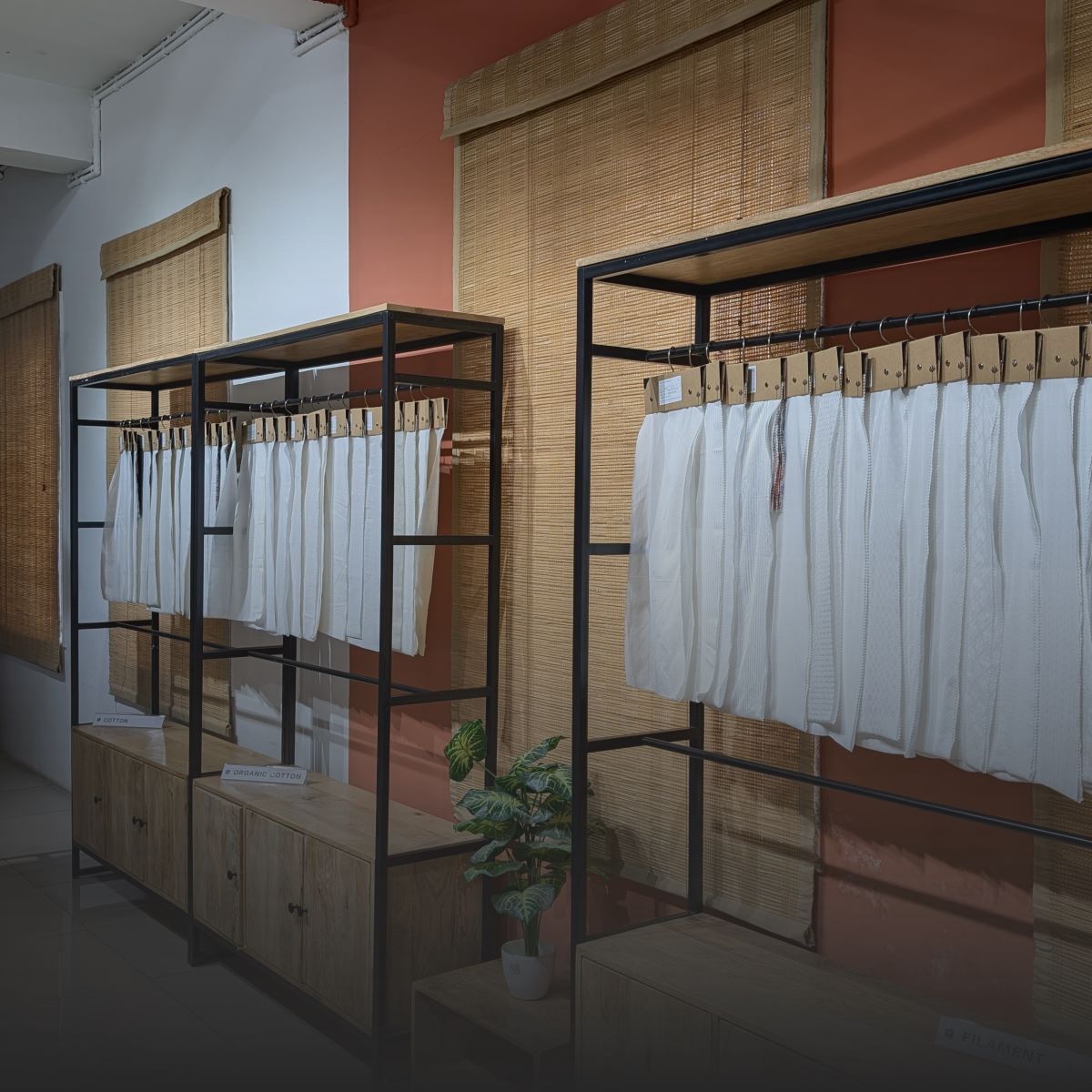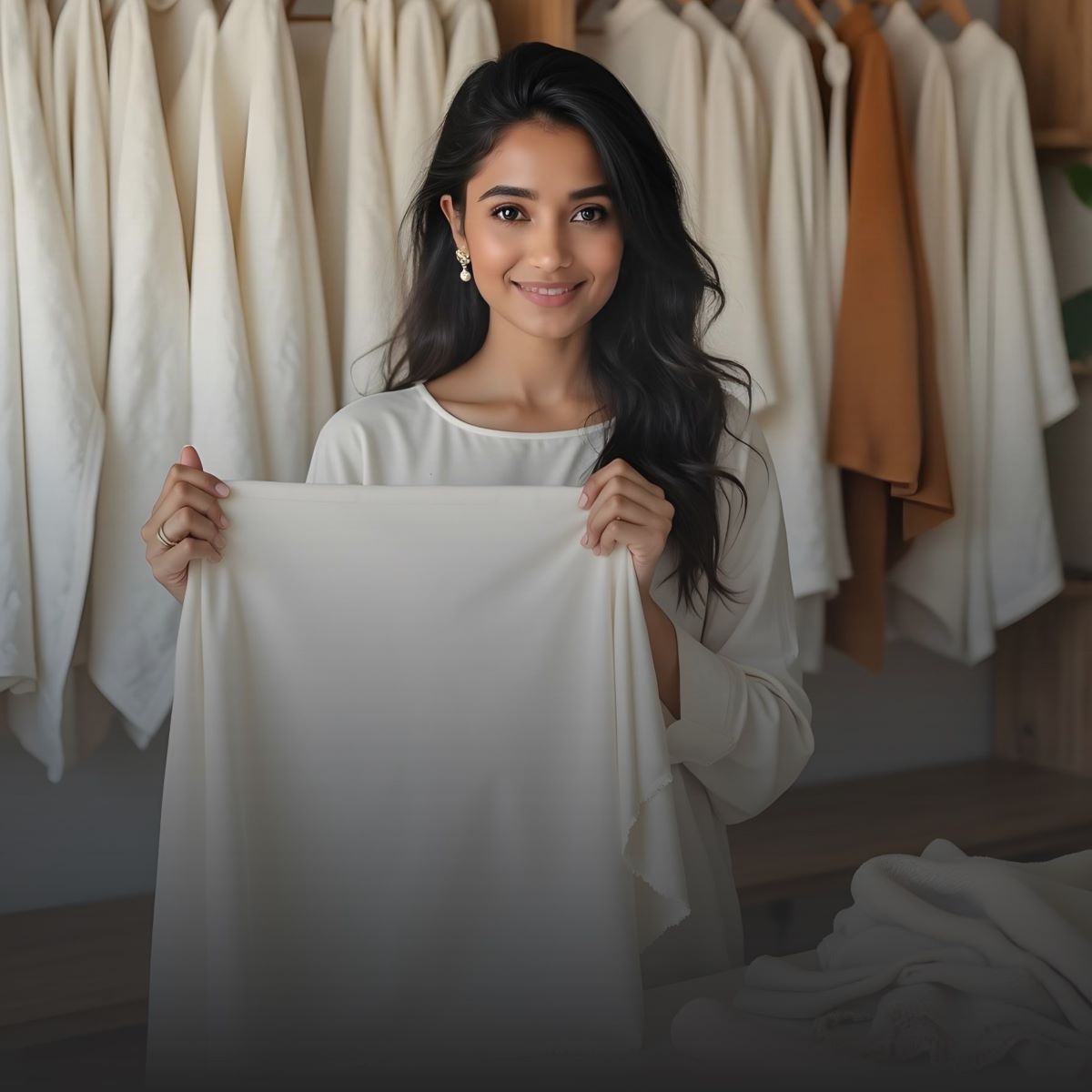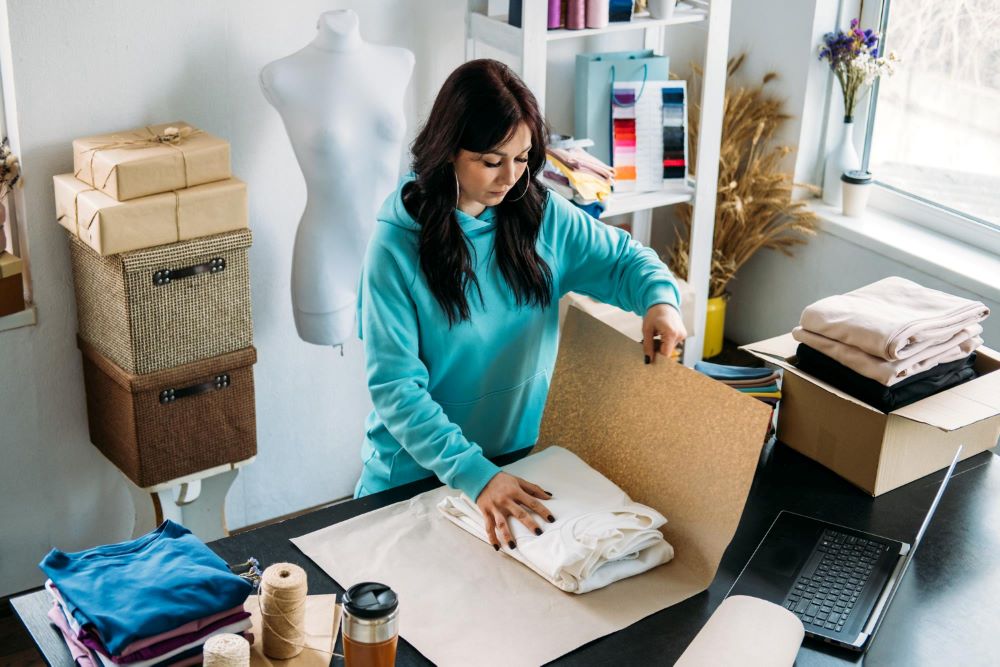You’ve got the designs. You’ve got the ideas. But without the right fabric, your collection might never reach its full potential.
For new fashion brands in the U.S., choosing the right cotton fabric is more than just picking a texture or color. It affects how your garments fit and feel and lastly, it can shape how your brand is perceived from day one.
This guide is for fashion startups, small apparel brands and private-label creators who want to make smart, informed choices. Whether you’re sourcing fabric for the first time or rethinking your current options, you’ll find what you need to move forward with clarity.
You Can Also Read : How To Build Pricing And Inventory For Your Clothing Line Business In USA?
You’ll learn:
- Why cotton is still the top fabric for most brands
- How to choose the right type and weight
- What mistakes to avoid
- Where to find high-quality cotton fabrics with low minimums
If you're looking for more sustainable options, explore our range of organic cotton fabric. For brands needing color consistency and ready-to-use materials, check out our cotton mill dyed fabric.
Or, start browsing our full cotton fabric collection to find the right match for your next drop.
Let’s look at why cotton remains the top choice for clothing brands.
1. Why Cotton Remains the Top Choice for Apparel Brands: A Trend Analysis
Cotton is one of the most widely used fabrics in the USA and continues to be the preferred choice for many apparel brands. It’s trusted by both brands and customers due to its flexibility, reliability and comfort. As you can see in the image above, recent Google Trends data shows cotton consistently outperforms other fabrics like silk, viscose, modal and linen in web searches over the past 12 months.
With a search interest score consistently above 50, cotton remains a clear leader, proving its enduring popularity across multiple garment categories.
Here’s why cotton works across various styles:
-
Works for many styles: From t-shirts and basics to dresses, loungewear, babywear, streetwear and casual sets, cotton adapts to different designs and markets, whether you're focused on price or quality.
-
Comfortable to wear: Cotton is breathable and soft, making it ideal for everyday wear, especially in warmer climates.
-
Easy to print and dye: Cotton absorbs color well, holding details and tones clearly, making it perfect for screen printing or digital prints.
-
Familiar to buyers: Labels that say “100% cotton” build buyer confidence. For sustainability-driven brands, certified organic cotton can enhance your eco-friendly message.
- Custom finishes available: Cotton can be pre-shrunk, brushed for softness or mercerized for added strength, offering more options to fine-tune your garments.
2. Understanding Different Types of Cotton Fabrics

When it comes to choosing the right cotton fabric, the options can be overwhelming. Different types of cotton fabrics can drastically change the way your designs look and feel. Here's what you need to know to make the right choice for your clothing line.
1. Woven vs. Knit Cotton
Cotton fabrics are either woven or knit and their structure affects how the fabric behaves.
-
Woven Cotton: This fabric is made by interlacing threads at right angles. It’s typically more rigid and less stretchy.
-
-
Poplin: Crisp and smooth, ideal for shirts, dresses and formal wear.
-
Twill: Known for its diagonal weave, it’s durable and works well for chinos, jackets and pants.
-
Poplin: Crisp and smooth, ideal for shirts, dresses and formal wear.
-
-
Knit Cotton: Made by looping threads together, knitted fabrics are stretchy and often softer than woven.
-
-
Jersey: A lightweight, stretchy fabric commonly used for t-shirts.
- Interlock: Thicker and smoother, commonly used for babywear or polos.
-
Jersey: A lightweight, stretchy fabric commonly used for t-shirts.
-
Each fabric type impacts how your garment drapes, stretches and feels on the skin.
Looking for high-quality knit cotton fabrics for your designs? Check out our collection for a range of stretchy, comfortable options.
2. Fabric Weight
Fabric weight is how thick the cotton is and is measured in grams per square meter (GSM). The weight affects how the fabric hangs and what types of clothes it's best for.
-
Lightweight (<150 GSM): Perfect for airy, breathable garments like blouses, shirts and summer dresses.
-
Midweight (150–250 GSM): Versatile enough for casual wear, dresses and t-shirts.
- Heavyweight (>250 GSM): Ideal for sturdy garments like jackets, pants and outerwear.
Always consider the fabric's weight when designing for comfort, fit and functionality.
3. Cotton Fabric Finishes
The finish of a fabric can enhance its texture, look and durability.
-
Brushed Cotton: Softened by brushing, giving it a fuzzy texture, commonly used for flannels and winter garments.
-
Mercerized Cotton: A treatment that increases luster and strength, often used for higher-end garments.
-
Preshrunk Cotton: Cotton that has been treated to minimize shrinkage after washing.
- Printed Fabrics: Pre-printed designs that can save time in production. If you're working with prints, consider looking for cotton printed fabrics for a variety of patterns and designs.
4. Cotton Fiber Types
Not all cotton is the same. The fiber type will determine the softness, durability and feel of the fabric.
-
Regular Cotton: Affordable and widely available. It’s perfect for everyday garments.
-
Combed Cotton: Treated to remove short fibers, making it smoother and stronger.
-
Organic Cotton: Sourced from non-GMO plants and grown without harmful pesticides, making it ideal for sustainable fashion lines.
- Pima / Supima Cotton: High-quality, long-staple cotton that is soft and durable.
If sustainability is a key part of your brand, organic cotton is a great option to consider.
5. Choosing the Right Cotton for Your Garment
Not all fabrics are suitable for every design. Here’s a quick guide:
-
T-shirts: Jersey or interlock cotton for stretch and comfort.
-
Shirts and blouses: Poplin or cambric for structure and smoothness.
-
Casual wear or work wear: Twill or French terry for durability.
- Outerwear: Heavyweight cotton like denim or canvas.
Ensure you select the fabric based on the specific needs of your garment.
3. Common Mistakes New Brands Make When Choosing Cotton Fabrics:

|
Mistake |
Description |
Tip |
|
1. Choosing Based Only on Appearance |
A fabric can look good but perform poorly. |
Ensure the fabric matches the function of the garment (e.g., no excess wrinkles or stretching). |
|
2. Not Accounting for Shrinkage |
Unwashed cotton often shrinks after the first wash. |
Always check if the fabric is preshrunk, test a small piece and add 3–5% tolerance to patterns. |
|
3. Overlooking Fabric Weight |
Weight affects drape and durability. |
Check GSM to ensure the weight is suitable for the garment (e.g., lightweight for pants, not too heavy for summer tops). |
|
4. Skipping Wear Tests |
What works in a sample may not work in real use. |
Wash, sew and stretch the fabric to test its real-world performance before investing further. |
|
5. Buying Without Support |
Risk of bad orders if you don’t understand fabric specs. |
Confirm MOQ, print-friendliness and shipping time before committing to the order. |
4. How to Choose the Right Cotton Fabric for Your Garment Type

Each garment type places different demands on fabric. The wrong fabric can lead to sizing issues, poor fit and customer complaints. The right one improves product quality and helps your design perform as expected.
Here’s how to make the right fabric choice by product category:
T-Shirts and Casual Tops
T-shirts and everyday tops need stretch, breathability and softness — especially if they’re worn close to the skin or layered.
-
Best fabrics: Jersey, interlock, slub knit
-
Recommended GSM: 140–180
-
Use for: Basics, activewear tops, branded tees
-
What to consider:
-
- Natural stretch for movement
- High breathability for comfort
- Smooth surface for clean printing
- Natural stretch for movement
-
Avoid woven cotton here — it won't drape well and restricts movement.
Shirts and Blouses
Shirts require a clean silhouette, especially for workwear or semi-formal collections. Fabric should hold its shape without stiffness.
-
Best fabrics: Poplin, cambric, cotton lawn
-
Recommended GSM: 100–130
-
Use for: Button-downs, officewear, uniforms
-
What to consider:
-
- Crisp surface for structure
- Lightweight for layering
- Smoothness for printing or embroidery
- Crisp surface for structure
-
- Browse our cambric cotton collection to explore fine options for shirting.
Dresses
Dress fabric depends on silhouette and season. You need to balance structure with flow — and consider whether it needs lining or not.
-
For draped or flowy styles: Voile, muslin, cotton lawn
-
For fitted or tailored styles: Twill, stretch poplin, cotton satin
-
Recommended GSM: 100–200
-
What to consider:
-
- Drape for movement
- Opacity for coverage
- Stitch quality for design detailing
- Drape for movement
-
- Explore our cotton voile fabrics for lightweight, breathable styles.
Bottoms (Pants, Skirts, Shorts)
Bottoms need fabric that holds its shape, resists wear and handles structure well — especially if your designs have pleats, pockets or fitted elements.
- Best fabrics: Cotton twill, canvas, denim
- Recommended GSM: 220–400
- Use for: Utility wear, tailored pants, structured skirts
- What to consider:
-
- Strength under tension
- Smooth construction for stitching
- Shrinkage and wrinkle resistance
- Strength under tension
-
- Check out our cotton twill fabric collection for structured silhouettes.
Loungewear and Innerwear
These categories require fabrics that are soft, breathable and gentle on the skin. Look for materials with natural stretch and high recovery.
-
Best fabrics: French terry, rib knit, brushed cotton
-
Recommended GSM: 180–250
-
Use for: Pajamas, tank tops, hoodies, joggers
-
What to consider:
-
- Soft finish that feels comfortable all day
- Good stretch retention
- Easy-care washability
- Soft finish that feels comfortable all day
-
- View our French terry fabric options for relaxed fits and premium feel.
Kidswear
Children’s clothing must be safe, soft and built to handle frequent washing. Lightweight cottons work best.
-
Best fabrics: Cambric, muslin, interlock knit
-
Recommended GSM: 100–160
-
Use for: Babywear, toddler outfits, playwear
-
What to consider:
-
- Gentle on sensitive skin
- Durable in daily wash cycles
- Non-toxic finishes or organic options
- Gentle on sensitive skin
-
- You can also consider organic cotton fabric if your brand values sustainability and safety.
Why Fabric Matching Matters
Choosing the wrong cotton can:
- Make your products wear out faster
- Lead to customer returns or bad reviews
- Cause production delays from poor performance
Matching fabric to garment type makes your collection stronger from the first sample to the final shipment. It also shows your customers that comfort, quality and care are part of your brand.
5. Key Factors to Consider When Sourcing Cotton Fabric in the U.S.

Sourcing cotton fabric in the U.S. involves more than just picking a material. It’s about considering factors like quality, cost and reliability. These elements play an important role in shaping the final product and ensuring timely delivery.
Here’s what you need to keep in mind when sourcing cotton fabric for your clothing line:
1. Fiber Type (Conventional vs. Organic)
The fiber type you choose affects both the cost and appeal of your garments.
-
Conventional cotton is more affordable and commonly available.
- Organic cotton is grown free from chemicals, making it softer and gentler on sensitive skin. It's also a great choice for eco-friendly brands aiming for sustainability.
Always verify the fiber type with your supplier. If you’re considering organic cotton, make sure they can provide certification to ensure authenticity.
2. Fabric Construction
How the fabric is woven or knitted affects the feel, stretch and appearance of your garments.
-
Woven fabrics (like cotton poplin and twill) are durable and have minimal stretch, making them ideal for structured garments like shirts, skirts and pants.
- Knitted fabrics (like jersey and interlock) offer stretch and are perfect for casual wear and activewear.
Make sure the fabric construction aligns with the garment type you’re producing. For example, choose woven fabrics for tailored pieces and knits for t-shirts or loungewear.
If you’re new to sourcing knits, explore our knitted cotton fabric collection to get familiar with various options.
3. GSM (Grams per Square Meter)
GSM measures the weight of the fabric, which is crucial for determining how the fabric will behave in your designs.
-
Lightweight cotton (80–130 GSM) is ideal for summer shirts, dresses and blouses.
- Heavier cotton (200–400 GSM) works better for outerwear, pants or structured garments.
Knowing the right GSM helps you choose a fabric that fits your design goals and intended use. Always test the fabric and request swatches to ensure the feel matches the specifications before ordering bulk quantities.
4. MOQ (Minimum Order Quantity)
Some suppliers set a high minimum order quantity (MOQ), which may not be ideal for small to mid-sized brands or emerging designers.
- If you’re just starting out or planning a limited run, find suppliers that offer low MOQs to avoid overstock and unnecessary costs.
- Fabriclore offers low MOQs that are perfect for smaller orders or sampling runs.
Check with your supplier to confirm their MOQ and see if it suits your production needs.
5. Lead Time and Availability
The time it takes to receive fabric after placing an order is crucial, especially if you have tight production timelines.
- Ask your supplier about their lead time — how long it takes from placing an order to receiving the fabric.
- Confirm the availability of the fabric you want. Some fabrics may not always be in stock or may have limited production runs.
Plan ahead and choose suppliers that offer reliable delivery times and clear communication about availability. This will help you avoid delays in your production schedule.
6. Customization Options
If you're developing a unique collection and need exclusive colors, prints or finishes, check if your supplier offers customization.
- Suppliers who provide custom fabric printing or dyeing give you more flexibility to create standout pieces that align with your brand identity.
- Always ask for samples or proofs before confirming a bulk order for custom fabrics.
7. Sustainability and Transparency
Consumers today are increasingly aware of where and how their clothing is made. Transparency in the fabric sourcing process is crucial for building trust with your audience.
- Choose suppliers who are clear about where they source their products and have sustainability certifications.
- Sustainability isn’t just about eco-friendly materials; it also includes ethical manufacturing processes and waste reduction efforts.
Being clear about where you source your fabric and focusing on sustainability can help your brand stand out and attract eco-friendly customers.
6. Where to Source Quality Cotton Fabric in the U.S.

Finding the right cotton fabric supplier is crucial for your clothing line. Here’s where to start when sourcing cotton fabrics within the U.S.
1. Domestic Manufacturers
U.S.-based manufacturers offer quick turnaround and consistent quality. They are familiar with local trends and standards, making them a reliable choice.
-
Pros: Faster shipping, quality control, clear communication.
- Cons: Generally higher prices due to labor costs.
Domestic manufacturers are a great option for timely and dependable results.
2. Online Platforms for Fabric Sourcing
Online fabric sourcing platforms let you browse a wide selection of cotton fabrics. They give you the flexibility to compare, order and make decisions remotely.
Top U.S.-based platforms include:
-
Fabriclore — Offers a variety of cotton fabrics at low moq.
-
Mood Fabrics — Known for a broad selection, including premium cotton fabrics.
-
Joann Fabrics — A go-to platform for fabric selection, including cotton.
These platforms are ideal for small orders or testing out different fabrics.
3. Local Fabric Stores and Wholesale Distributors
If you prefer seeing fabric in person, local stores allow you to touch and inspect before purchasing. Many also connect you to wholesale distributors, which are ideal for larger orders.
-
Pros: Direct inspection, personalized service.
-
Cons: Limited variety and sometimes higher costs.
For bulk orders, connecting with a wholesaler directly can give you access to better pricing and larger quantities.
4. Trade Shows and Fabric Fairs
Attending fabric trade shows lets you meet suppliers and see fabrics in person. These events give you a chance to explore many types of cotton materials.
Popular shows include Texworld USA and The LA Textile Show.
-
Pros: Face-to-face connections, exclusive fabric selections.
- Cons: Travel costs and scheduling constraints.
Trade shows provide valuable insights and can help you discover fabrics not available online.
5. Custom Development and Printing Services
Custom printing services let you add your designs or patterns to cotton fabrics, making your clothing line unique. Many suppliers offer this service for low minimum order quantities.
-
Fabriclore provides custom printing on high-quality cotton, allowing you to design unique pieces for your collection.
- Check other suppliers for similar services, ensuring they meet your quality standards before ordering in bulk.
6. Ethical and Sustainable Fabric Sourcing
Consumers are increasingly drawn to sustainable fashion. If your brand values eco-friendliness, sourcing organic cotton or ethically produced fabrics can help build trust with your audience.
Look for suppliers who offer:
-
Organic cotton with certifications like GOTS.
- Sustainable manufacturing practices and eco-friendly dyes.
Sustainable sourcing is not only good for the planet but can also strengthen your brand’s reputation.
Start by exploring platforms like Fabriclore for a broad range of cotton fabrics with customizable options. Whether you need small quantities or large orders, sourcing from U.S.-based suppliers gives you the flexibility and reliability needed to grow your brand.
Also Read: How To Set Up Production And Manufacturing For Your Clothing Business Line In The USA
Conclusion

Choosing the right cotton fabric is key to making your clothing line stand out. From fabric types to weight and finish, every detail impacts how your designs look and feel. Understanding these factors helps you create quality garments that fit well and perform as expected.
Sourcing from reliable U.S.-based suppliers with low MOQs and clear sustainability practices ensures you get the right fabric for your brand. By testing fabrics and selecting trusted suppliers, you can avoid costly mistakes and build a strong, successful collection.
FAQs
What is the best fabric for a clothing line?
Cotton is often the best fabric for clothing lines because it’s comfortable, breathable and versatile. For casual wear, try fabrics like jersey or poplin. For premium items, consider Pima or Supima cotton.
Is 65% polyester and 35% cotton good?
Yes, a 65% polyester and 35% cotton blend is a good choice. It’s durable, wrinkle-resistant and dries quickly. However, it’s not as breathable as pure cotton, so it may not feel as natural on the skin.
Which type of cotton is best for clothes?
Pima or Supima cotton is great for soft, durable clothing. For everyday wear, combed cotton works well. Organic cotton is ideal for eco-friendly brands.
How to choose the right fabric for clothes?
Choose fabric based on the garment type and purpose. Lighter fabrics like voile are perfect for summer clothes, while heavier fabrics like denim are ideal for outerwear. Consider the fabric’s weight, comfort and stretch to match the look and feel you want.
If you want to buy wholesale fabric in the USA, start by finding a trusted supplier that offers good quality fabric at affordable prices. Buying in bulk can help you save money, whether you’re a fashion designer, business owner, or someone who loves sewing. Choose a supplier that gives you many fabric options, low minimum order, and fast delivery. This way, you can easily get the materials you need for your projects.
We also happen to be a magnet for suggestions, and would love to catch yours….throw us yours on hello@fabriclore.com




